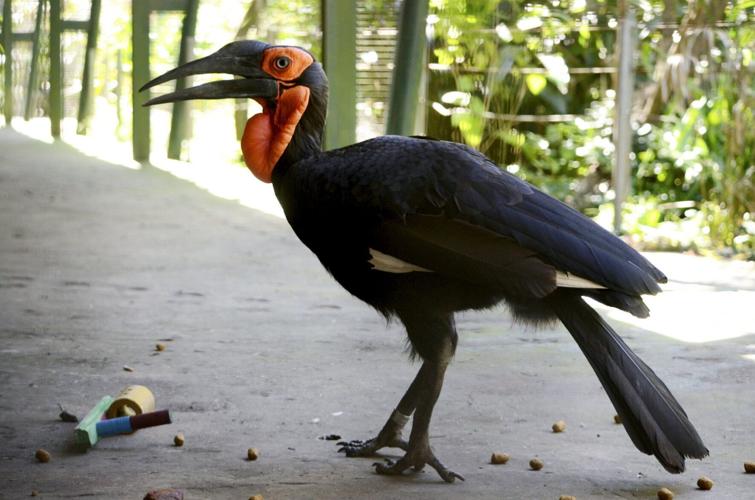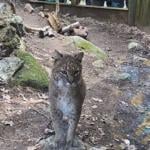
Southern Ground Hornbill (Bucorvus leadbeateri) pictured with the novel object used in the testing. (Jimena Lois-Milevicich via SWNS)
By Stephen Beech
Some birds are naturally "chicken" - scared of anything new, reveals new research.
Flamingos are among the most wary species, while falcons and pheasants are the least intimidated, say scientists.
The largest-ever study of neophobia - the fear of novelty - has discovered the key reasons why some birds are more fearful of new things than others.
The findings, published in the journal PLOS Biology, suggest that diet and migratory habits help shape neophobia in different species.
The global study was led by Dr. Rachael Miller while at Anglia Ruskin University (ARU) and the University of Cambridge.
The study involved 129 researchers from 82 institutions around the world.
Testing and other associated research tasks took place in 24 countries across six continents.

Blue-fronted Amazon parrot (Amazona aestiva) pictured with the novel object used in the testing. (Jimena Lois-Milevicich via SWNS)
Dr Miller explained that neophobia plays a "crucial" role in how animals balance risk and opportunity.
While caution can protect individuals from potential threats, she says it can also limit their ability to adapt to new nesting sites, foods or changes in the environment.
The research team investigated why some birds are more cautious than others when encountering unfamiliar objects while feeding.
Using standardized methods, in separate tests, each bird was presented with familiar, desirable food items, both alone and alongside a new object.
The new objects were designed with consistent colors and textures, and scaled proportionally to the size of each species.
Researchers then measured the time taken to touch the food in both scenarios, with increased hesitation in the presence of the object interpreted as neophobia.
Grebes and flamingos exhibited the highest neophobia, according to the findings.
Falcons and pheasants were among the least neophobic species, approaching food quickly regardless of the unfamiliar item.

Black-legged Seriema (Chunga burmeisteri) pictured with the novel object used in the testing. (Jimena Lois-Milevicich via SWNS)
Overall, across all 1,439 birds and 136 species tested – representing 25 taxonomic orders from penguins to parrots – the study found that dietary specialization and migratory behavior strongly predicted neophobia.
Dr. Miller said: “Neophobia comes with benefits and costs.
"Neophobic responses can protect an individual from potential risks, but may also decrease opportunities to exploit novel resources, such as unknown food or nesting sites.
“Neophobia plays an important role in assessing how species might respond to change.
"Species that are more wary of unfamiliar objects or situations may struggle to adapt to factors such as climate change or urbanisation, while those with lower neophobia may be more flexible or resilient."
She says birds with narrower diets may experience fewer variations in environmental stimuli and therefore may perceive changes as being more threatening than general feeders who are usually faster to explore and exploit different food types.
Dr. Miller said migratory birds may face "increased risks" linked to interacting with a wide range of potentially dangerous novel items and environments, and neophobia may be "evolutionary beneficial" for those species.
The researchers found that individual birds usually behaved consistently in their responses over time – one that was hesitant to approach a novelty in one trial was similarly hesitant when tested again several weeks later, suggesting neophobia to be a stable trait.

Blue-fronted Amazon parrot (Amazona aestiva) pictured with the novel object used in the testing. (Jimena Lois-Milevicich via SWNS)
Birds tested together were more neophobic than those tested alone, which was contrary to expectations that social presence might reduce fear through shared risk.
The researchers believe individuals may be affected by other birds’ fear cues or may wait to allow others to take the risk of approaching first.
Dr. Miller conducted the research alongside a team from the ManyBirds Project.
She said: “Our study also highlights the power of big team science.
"Through the ManyBirds Project, we were able to pool data and expertise from across the globe, helping us to uncover the hidden rules shaping animal behavior on an evolutionary scale.”
Dr. Miller co-founded the ManyBirds Project with Dr. Megan Lambert in February 2021.
Dr. Lambert, of the University of Veterinary Medicine, Vienna, said: “Our findings have important implications, particularly for species experiencing habitat change or being reintroduced into the wild from captive breeding programmes."
She added: “By better understanding these behavioral tendencies, conservationists can tailor strategies to improve the chances of survival in at-risk species.”
























(0) comments
Welcome to the discussion.
Log In
Keep it Clean. Please avoid obscene, vulgar, lewd, racist or sexually-oriented language.
PLEASE TURN OFF YOUR CAPS LOCK.
Don't Threaten. Threats of harming another person will not be tolerated.
Be Truthful. Don't knowingly lie about anyone or anything.
Be Nice. No racism, sexism or any sort of -ism that is degrading to another person.
Be Proactive. Use the 'Report' link on each comment to let us know of abusive posts.
Share with Us. We'd love to hear eyewitness accounts, the history behind an article.